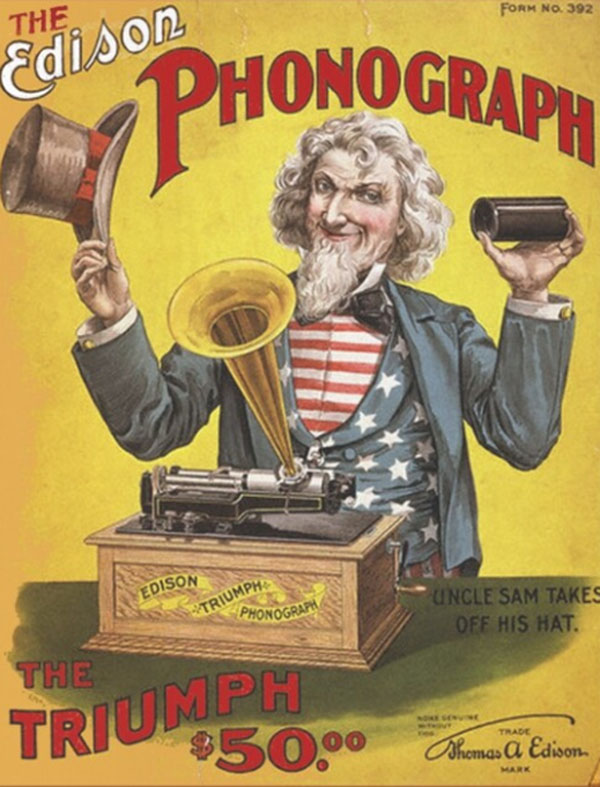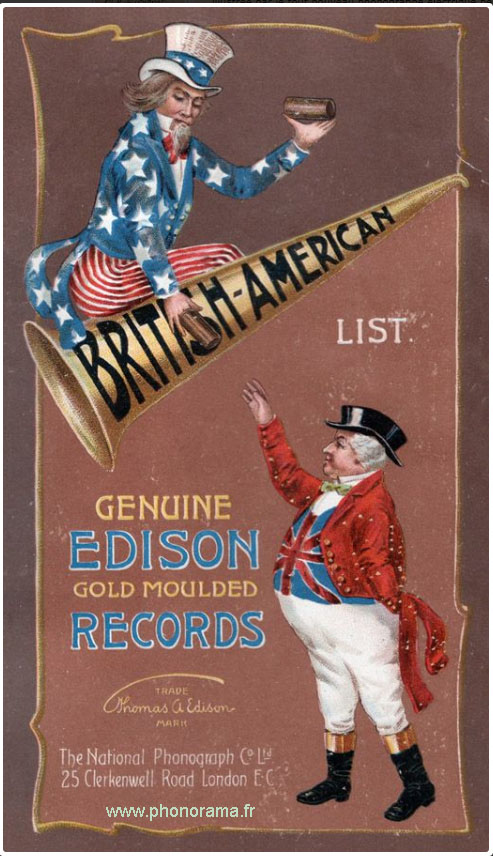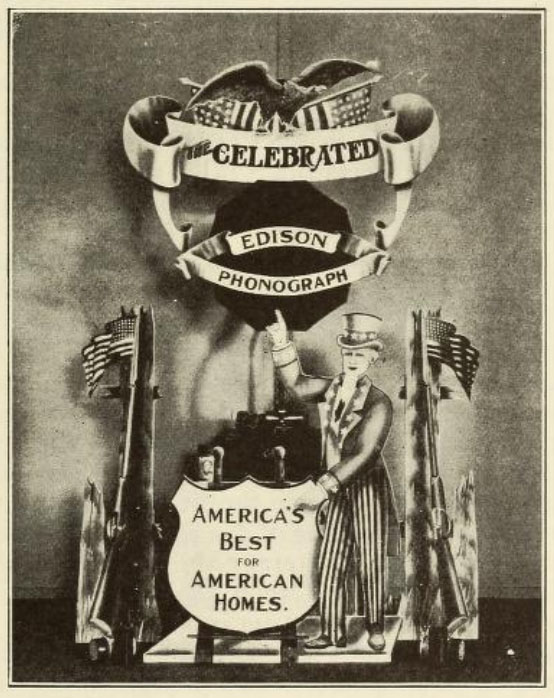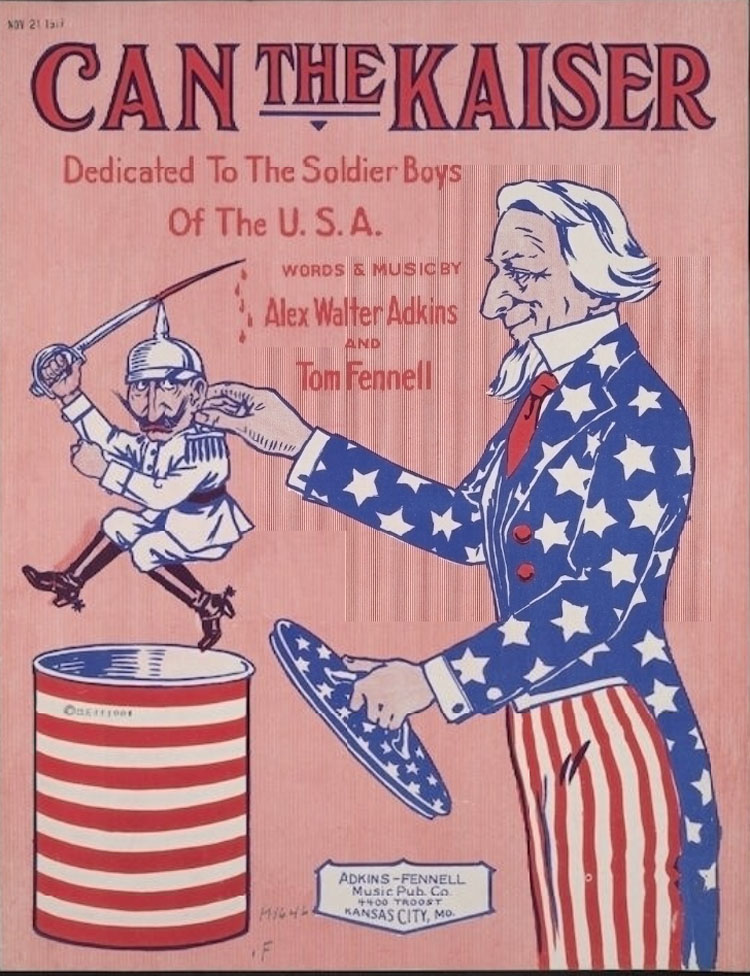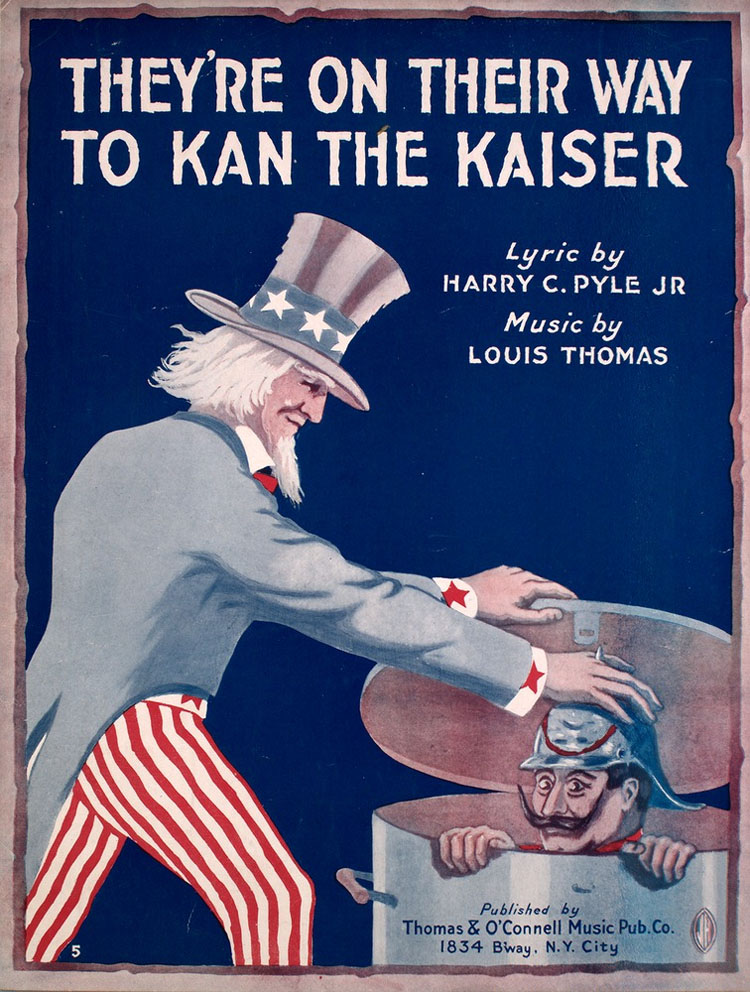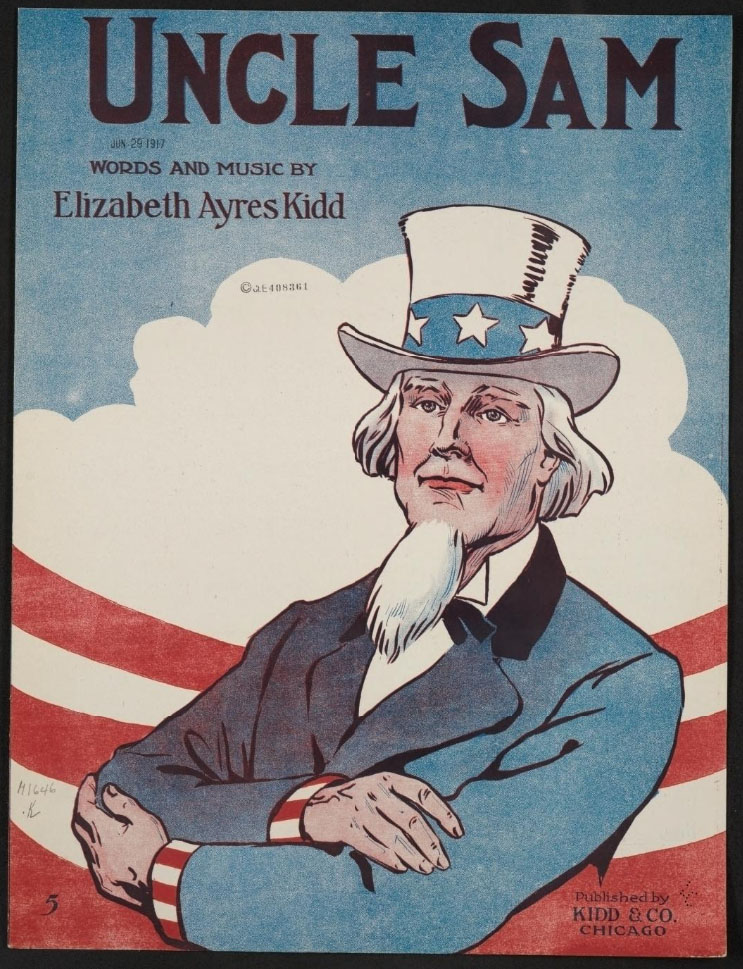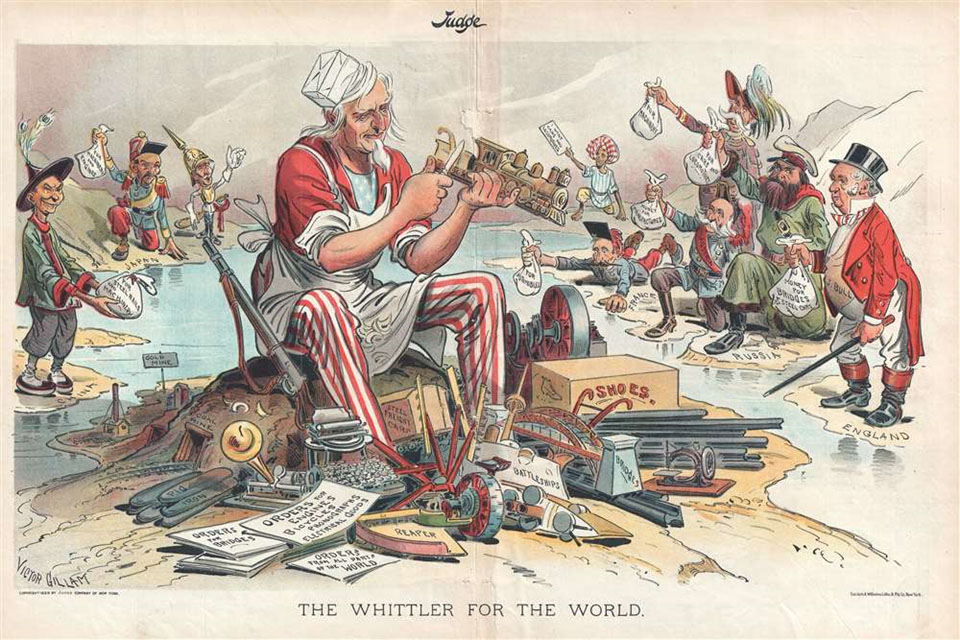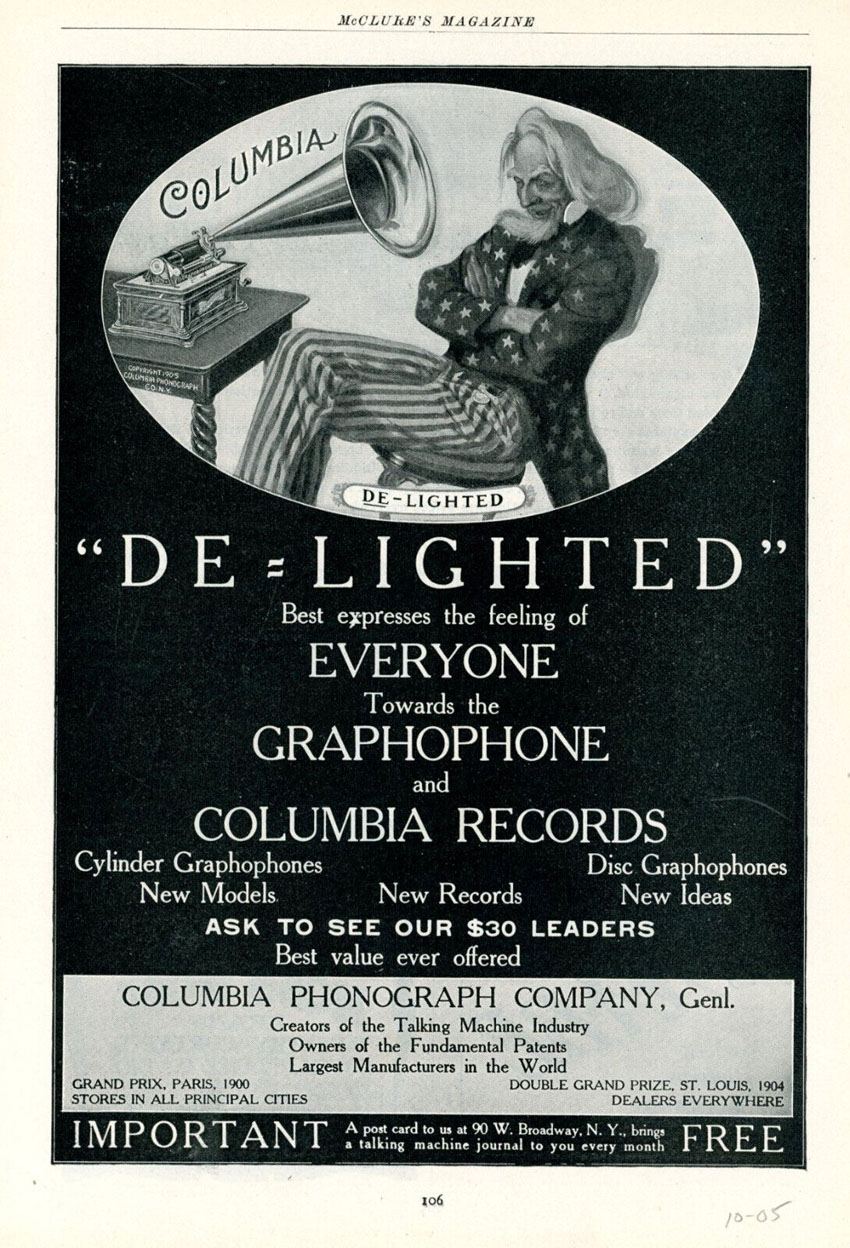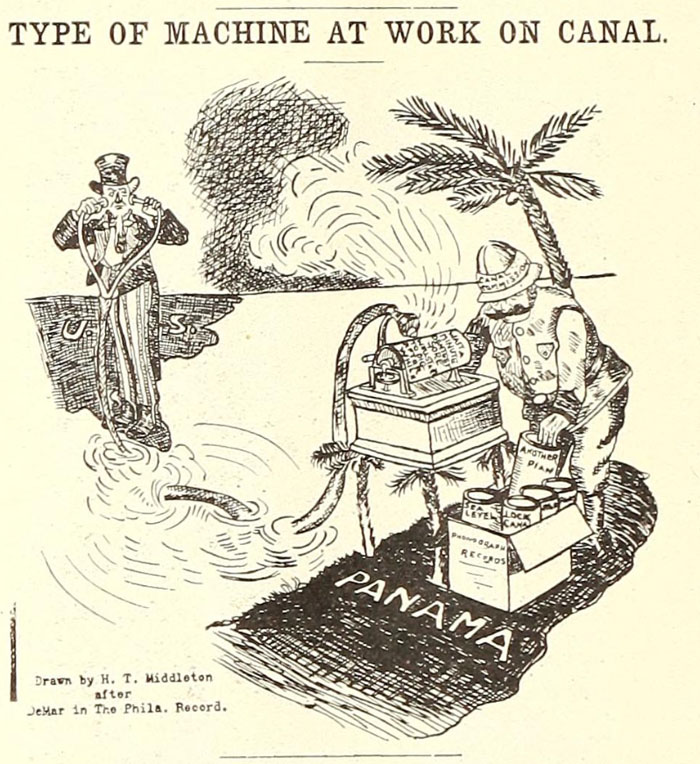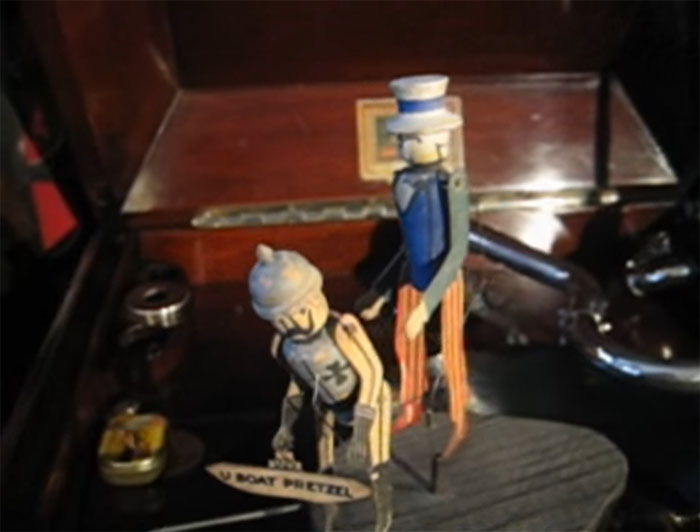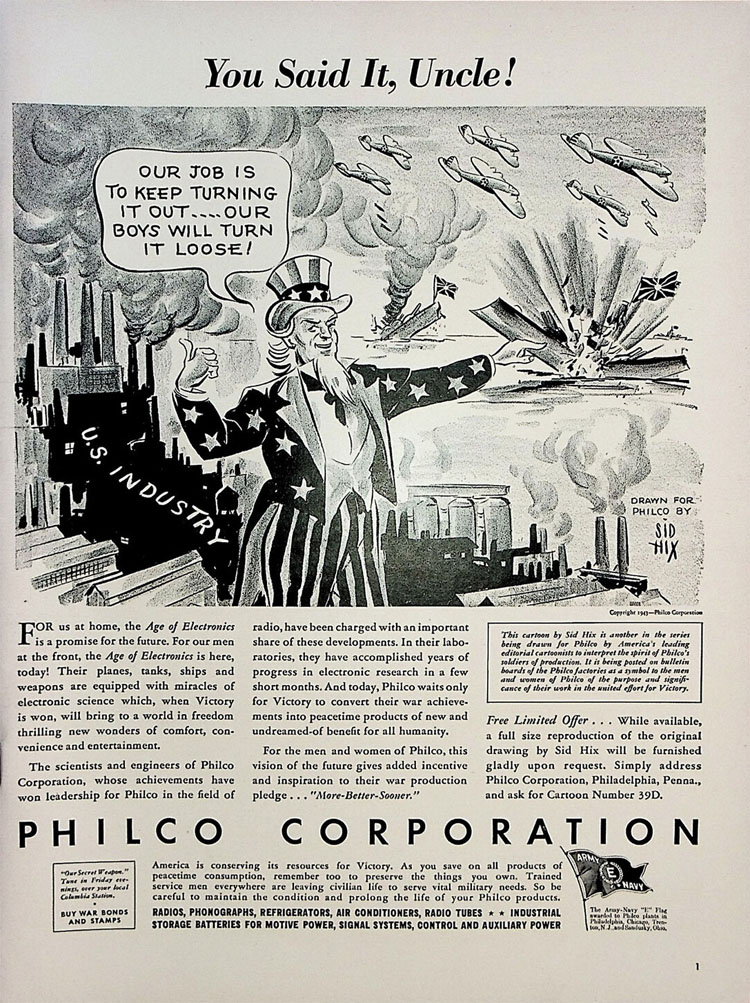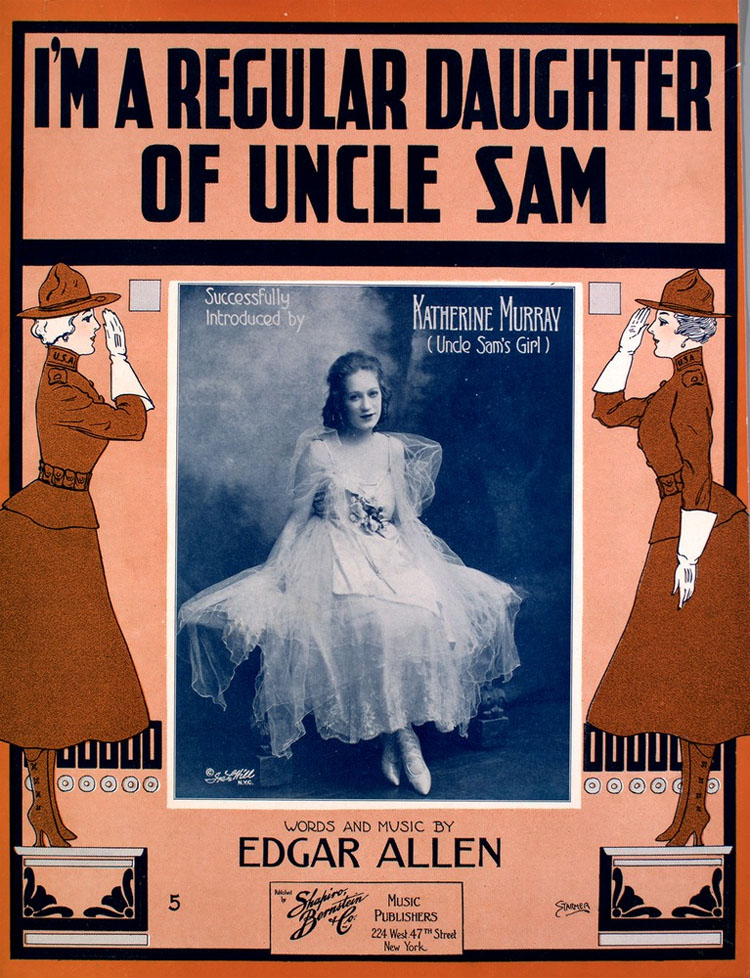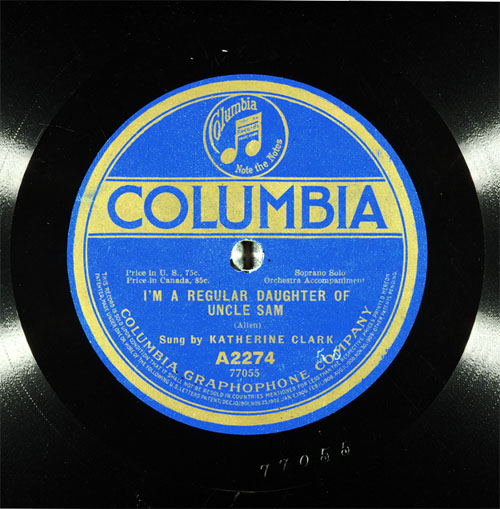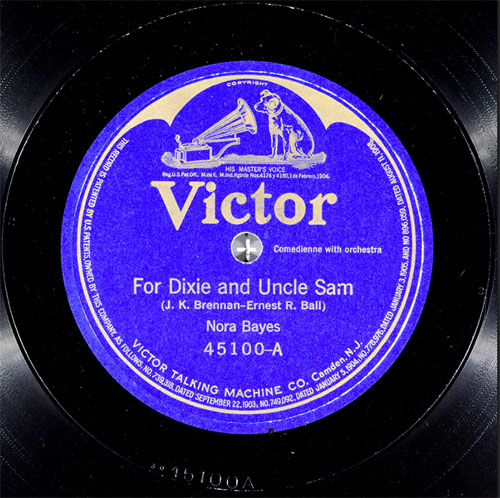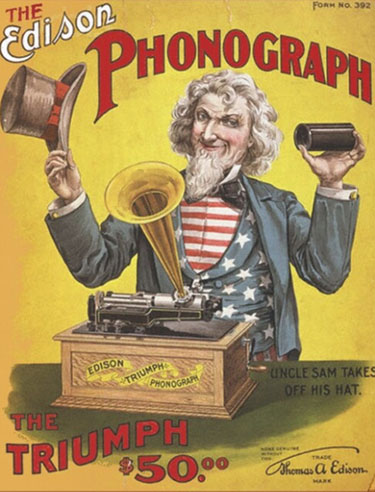
Uncle Sam and the Phonograph
By Doug Boilesen 2022
The phonograph's advertising history
includes hundreds of advertising themes and rationales for purchasing
specific brands and models of machines and records. There were testimonials
and advertisements featuring opera stars, recording artists, band
leaders, and comic storytellers. Various
fictional characters were also important like Nipper for the Victor
Talking Machine; Miss Columbia for the Columbia Phonograph Company;
and Santa
Claus who was ready to deliver multiple brands of phonographs
to countless homes since the phonograph was repeatedly advertised
as being the perfect gift for every member of the family.
Uncle Sam, a symbol of the United
States of America, was another one of the fictional characters who
would be seen in phonograph ads. Whether or not Uncle Sam was a
fully trusted salesman after the civil war was probably dependent
on the Mason-Dixon line and politics, but by the time of the World's
Columbian Exposition of 1893 Uncle Sam was promoting many products.
Fifty years after the civil war Nora
Bayes' 1916 hit song and record "For
Dixie and Uncle Sam" is a popular culture example that
grandparents may have served in the grey or the blue but it was
now time for all to wave the American flag in support of Uncle Sam:
Your Granddad fought in the war
of Sixty-One, He wore a suit of grey.
Your Daddy, too, in a unit of
navy blue, To Cuba sailed away.
Though the one wore grey and
the other blue, The blood of both's in you;
So I'm giving you up to Old Glory,
And I'm mighty proud that I am!
You're all I've got, but be Johnny
on the spot, For Dixie,
and Uncle Sam!
During World War I Uncle Sam was the
face of the United States' Army and Navy with their enlistment campaign
having been successfully supported using the "well-known
recruitment image of Uncle
Sam" created by James
Montgomery Flag.
Flag's illustration of Uncle Sam established
the "standard appearance" of Uncle Sam for the following
decades. Perhaps that World War I ad campaign could be called Uncle
Sam's ultimate sales program. Unfortunately, Uncle Sam would be
needed again for World War II.
In 1950
Uncle Sam was officially adopted as a national symbol of the United
States of America.
Although Uncle Sam supported multiple
consumer products from the 1870's and on, there are relatively few
examples of Uncle Sam advertising the phonograph. When the phonograph
began its home entertainment advertisements in popular culture circa
1895 there was no Uncle Sam raising his hat to the phonograph until
Edison's triumphant 1901 phonograph poster (top of this page and
below).
Uncle Sam as a phonograph salesman
was probably most appealing and persuasive in his ads after Teddy
Roosevelt became President when Uncle Sam was seen "de-lighted"
and simply enjoying the phonograph. Uncle Sam's delight was also
complemented by other popular culture examples of Uncle
Sam expressing his pride in the phonograph as an American product
and an example of the American spirit of inventiveness and genius,
or American wizardry as in the case of Thomas Alva Edison.
Besides phonograph ads, Uncle Sam
would be connected with the phonograph in cartoons, mechanical motion
toys attached to phonographs, sheet music and the respective records,
and a coin-operated device named "Uncle Sam's Entertainer"
which could be used with any standard disc record.
The first advertisement with a phonograph
in it was a Mrs. Potts' ad for her Sad Irons in Frank Leslie's
Illustrated Newspaper, June 1, 1878. However, that ad wasn't
selling the phonograph, and it wasn't 'exactly' Uncle Sam as it
was most likely the other American symbol of the time, Brother Jonathan.
For the purposes of this gallery,
however, the 1878 Mrs. Potts' ad is displayed here as the first
example of Uncle Sam with the Phonograph. (For purists perhaps an
asterisk can be added -- for details related to the identification
of Brother Jonathan in that 1878 Mrs. Potts' ad see Phonographia's
"Uncle
Sam and Brother Jonathan: Salesmen 1876 - 1900.")
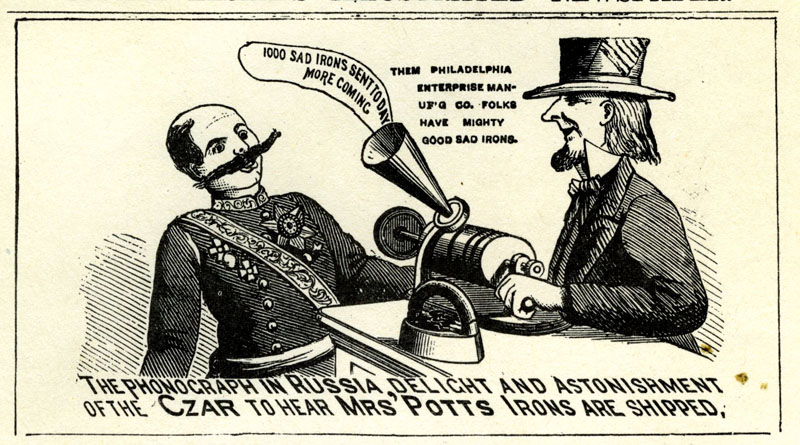
Frank Leslie's Illustrated Newspaper,
June 1, 1878
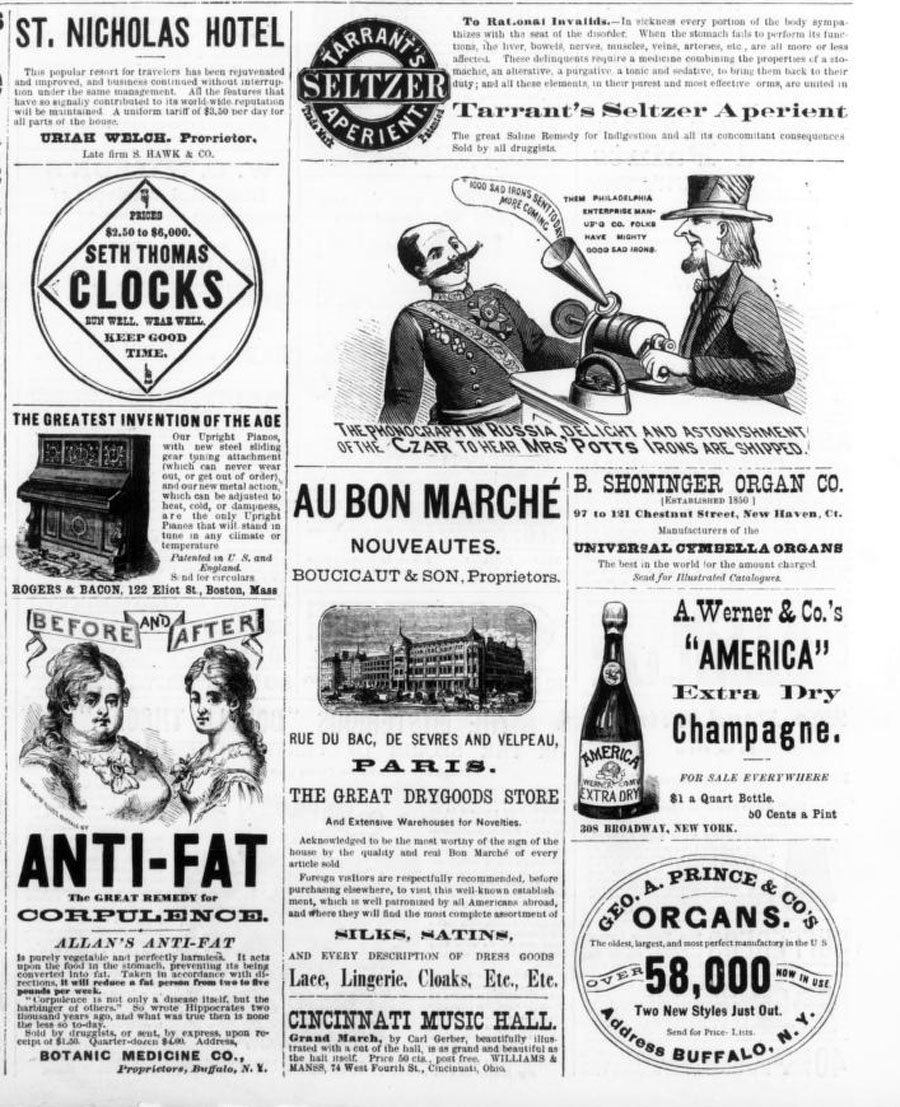
FACTOLA: The
earliest example of a phonograph
being part of an advertisement, but not with the intention of
selling a phonograph in that ad, is the June 1, 1878 illustration
in Frank Leslie's Illustrated Newspaper. In this ad Brother
Jonathan (a symbol of the United States in general, and an allegorical
figure of U.S. capitalism) is promoting the export of Mrs. Potts'
Sad Irons to Russia by bringing the message to the Czar of their
pending delivery by means of the recently invented Edison tinfoil
phonograph.
Uncle Sam promoting Hub Gore Makers
Elastic for Shoes in an 1894 trade card (below) was selling shoes,
not selling Edison Phonographs so like the 1878 Mrs. Potts' Sad
Irons ad the following isn't a phonograph advertisement. But of
all the promotions which used Uncle
Sam as a salesman at the World's Columbian Exposition of 1893,
Hub Gore Makers is by far the most interesting since there actually
was an exhibit at the Exposition which featured an effigy of Uncle
Sam "speaking" his Hub Gore sales message by means of
an Edison Phonograph. For that story and related details see The
Antique Phonograph's “Rest
about 10 seconds between speeches.” The Uncle Sam Mystery
at the 1893 World’s Fair by Allen Koenigsberg, March 2023.
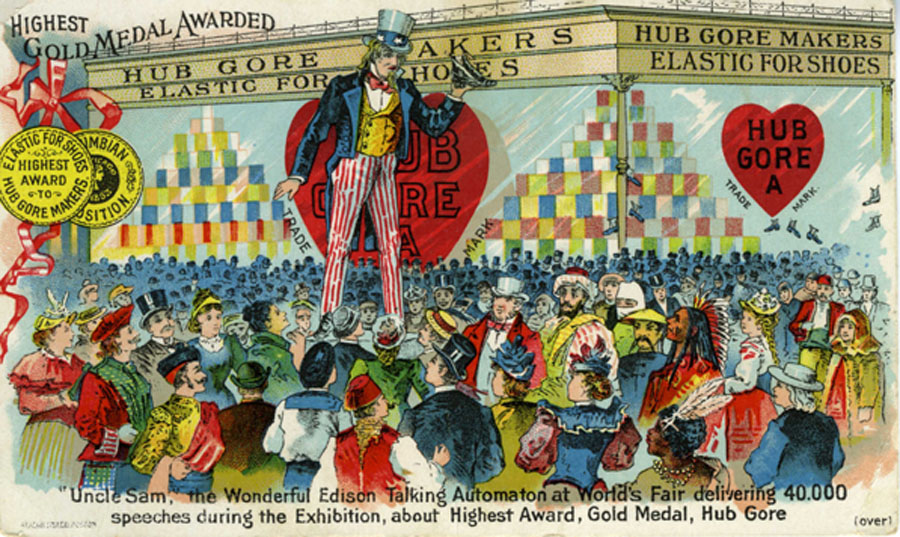
Uncle Sam promoting Hub Gore Makers
"Elastic for Shoes" with the automaton using an Edison Phonograph
to "talk."
(Beacon Lith Co., Boston, March,1894)
(PM-0650)
Hub Gore Makers circa 1897 added a
seated "Uncle Sam" to their business stationery presumbably
because their Uncle Sam Edison Phonograph automaton at the Exposition
had made Uncle Sam their official salesman. It was "America's
Ideal Shoe."
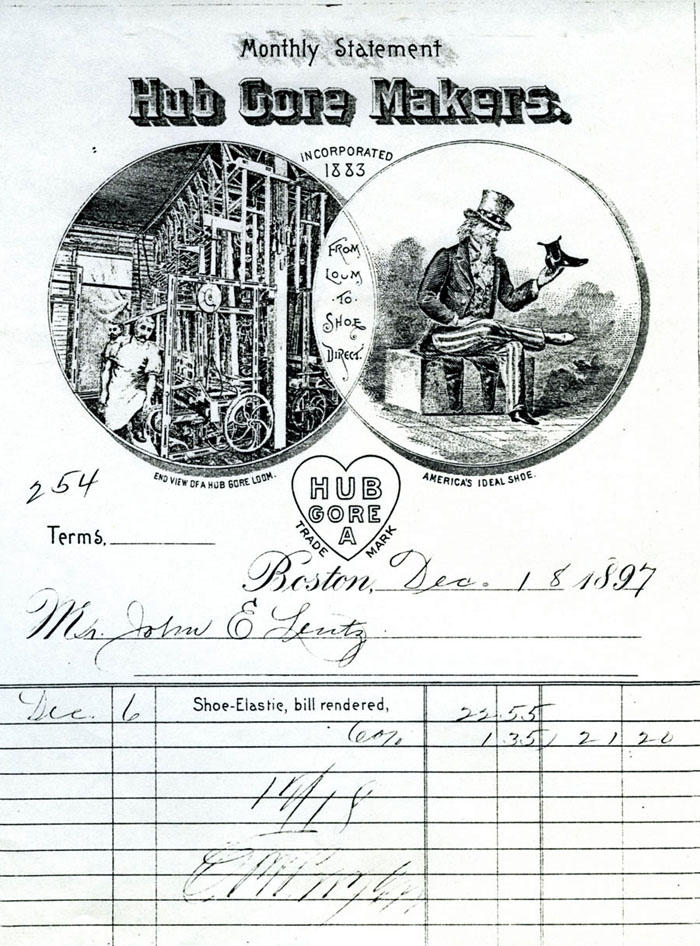
Monthly Statement Hub Gore Makers.
December 18, 1897 (Source: The Warshaw Collection of Business
Americana, Archives, Smithsonian Institution.)
As a symbol of the United States Uncle
Sam promoted and protected American interests in trade and global
markets. The following 1898 illustration shows American accomplishments
and Uncle Sam's pride in the recent products the United States of
America had introduced -- one of those being the Phonograph. Note
that this ad makes it clear that Uncle Sam's modern inventions aren't
just for the world, they are "Up to date ideas for the Universe."
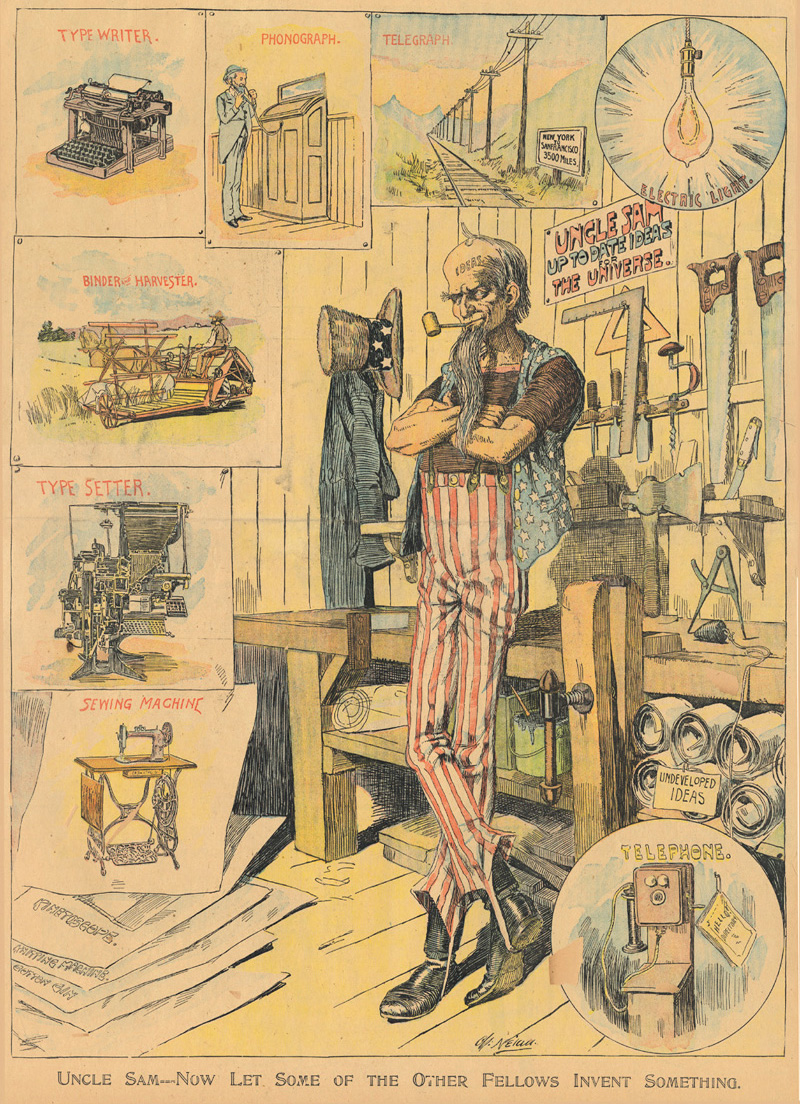
Uncle Sam - Inventing the phonograph,
et al. - The New York Herald
by Charles Nelan, 1898
Uncle Sam making American
products (including what appears to be a Columbia graphophone) and
taking sales orders from the world, Judge, 1899.
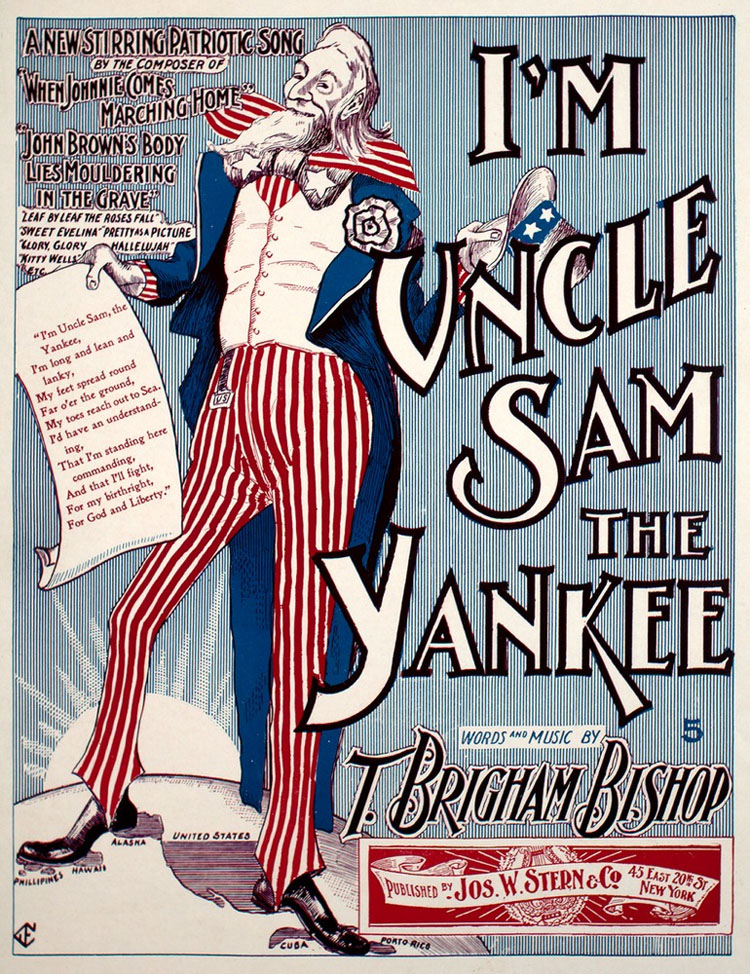
Edison Form 392, circa
1901
"Uncle Sam Takes
Off His Hat" to honor the phonograph in an advertising poster
for the Edison Triumph, Model A, introduced in 1901 with a 14"
brass horn "a speaking tube could be specified instead of
the horn. A two-way hearing tube was also supplied." (Frow
and Sefl, The Edison Cylinder Phonographs 1877-1929, ©1978).
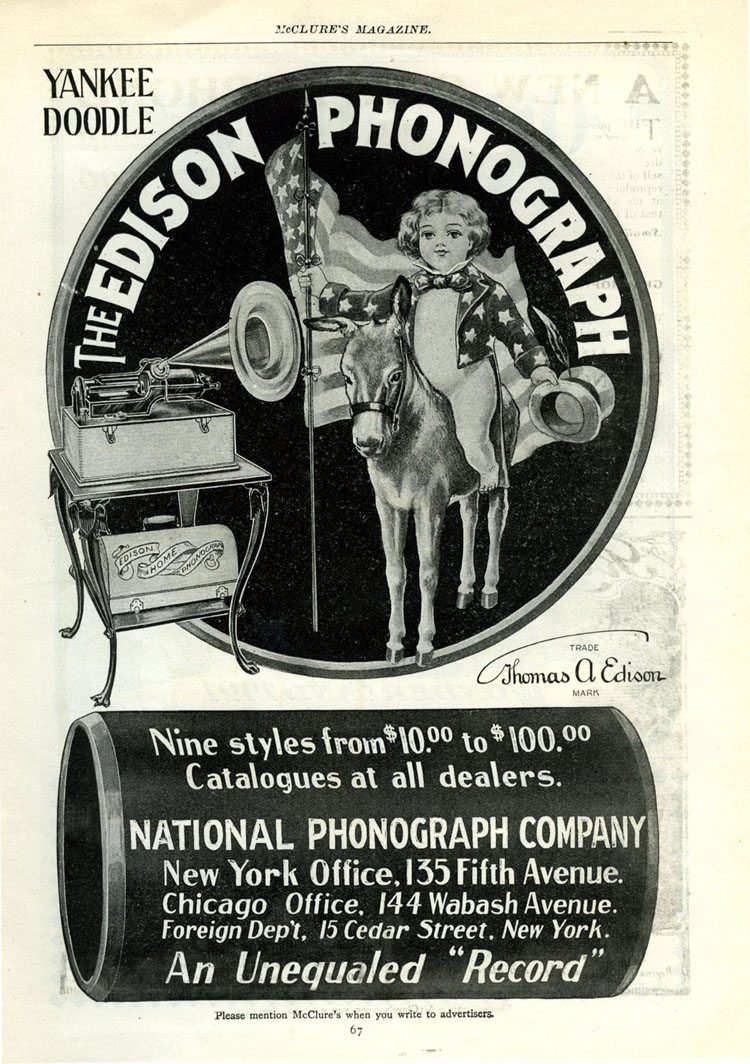
"Yankee Doodle,"
The Edison Phonograph, McClure's 1901 (PM-0941)
Yankee Doodle was an earlier symbol
of American pride before Uncle Sam. This Edison phonograph ad combined
that song and theme with a child-dressed like Uncle Sam holding
an American flag and riding a pony.
Teddy Roosevelt was the new President
in 1901 and was "De-Lighted" to meet everyone. The phrase
became part of American popular culture.

Harper's Weekly, June 18, 1904
Columbia used "de-lighted"
in several ads and catalog covers with Uncle Sam "De-Lighted"
as he listened to the Columbia Graphophone.
A Zon-o-Phone advertising card used
a bear instead of Uncle Sam as the one being "De-lighted"
(the bear, of course, was also associated with Teddy Roosevelt and
his namesake the "Teddy Bear" which first appeared in
1903).
McClure's Magazine,
October 1905
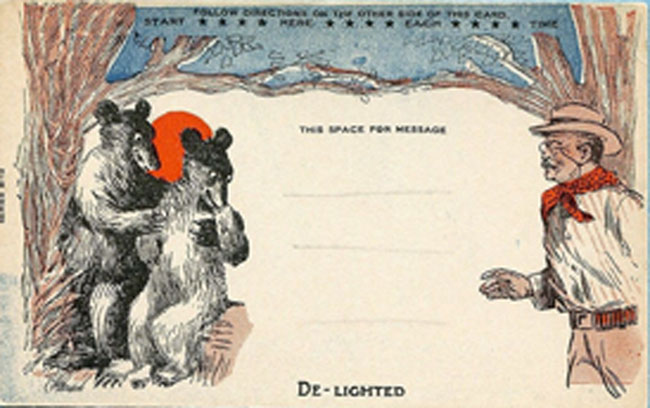
Postcard c. 1905
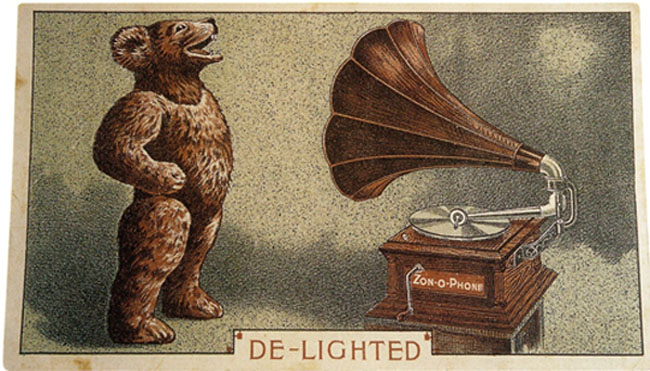
Postcard, circa 1907
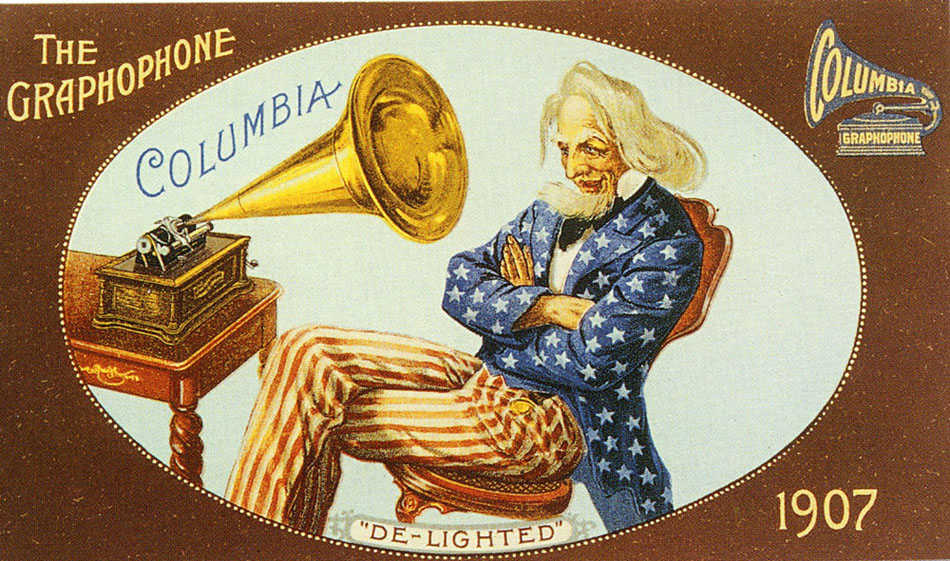
Uncle Sam "De-Lighted,"
Columbia Graphophone Catalog cover, 1907
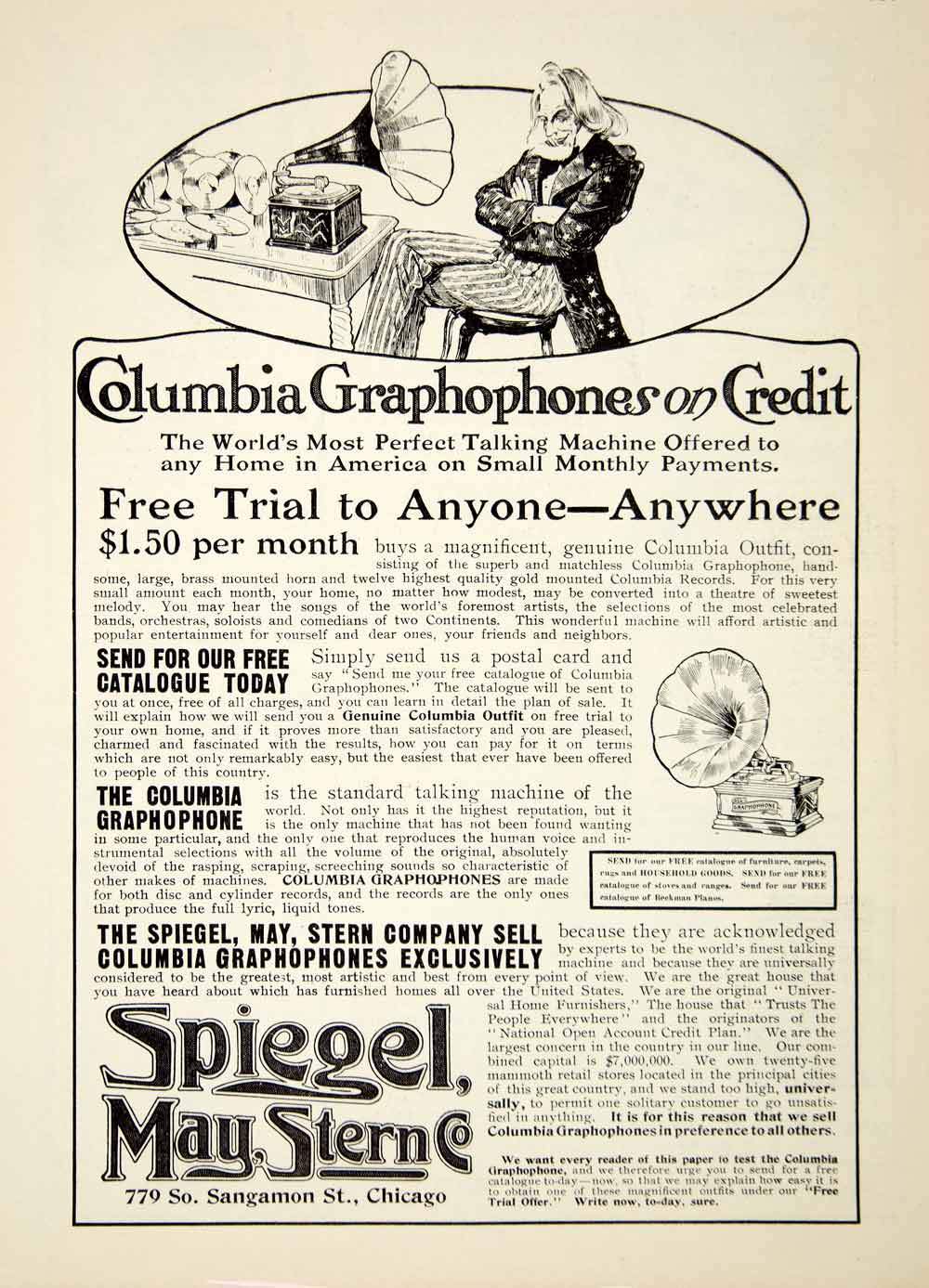
"Columbia Graphophones on Credit"
- Spiegel, May, Stern Co., 1907
The London branch of
Edison's National Phonograph Co. featured Uncle Sam offering Edison
Gold Moulded Cylinder Records to John Bull on this poster circa 1905.
(Source: phonorama.fr)
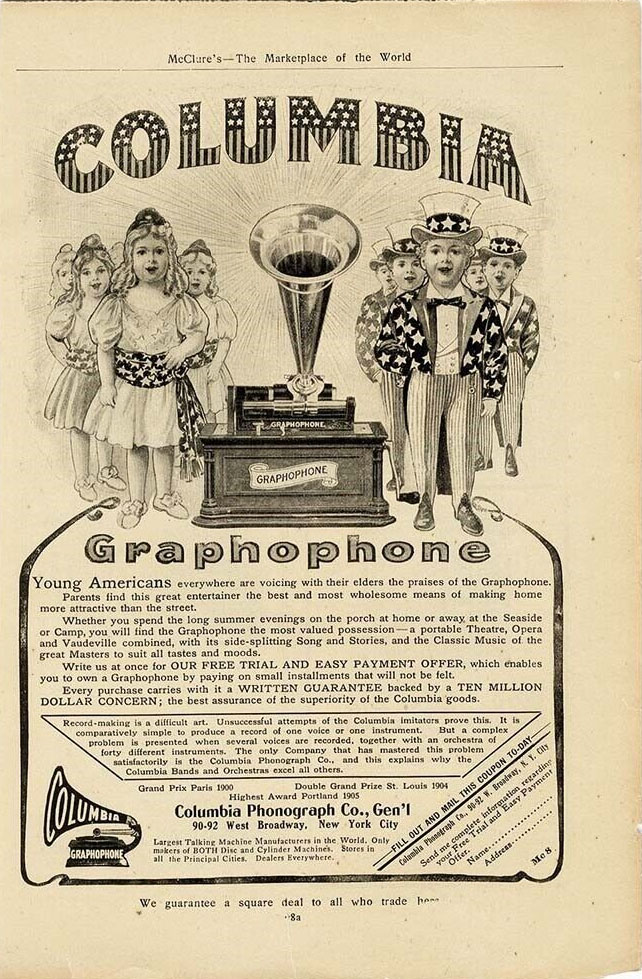
The Columbia Graphophone, McClure's
1906
Young Americans, dressed
as Miss Columbia and Uncle Sam singing the "praises of the
Graphophone."
Cartoon of Uncle Sam listening
to Panama Canal plans on phonograph records, The
Talking Machine World, January 1906
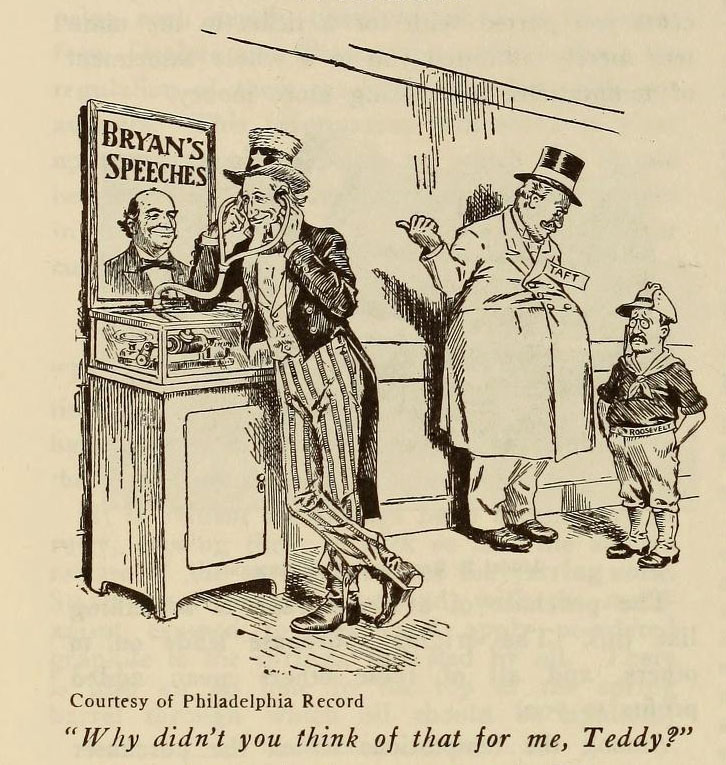
Edison
Phonograph Monthly, August 1908
William Jennings Bryan, in his Presidential
bid of 1908 recorded a series of cylinder phonograph records for
the Edison Phonograph Company. In this cartoon, Taft is seen complaining
that he has missed out on this innovative campaigning. The
Edison Phonograph Monthly in September 1908, however, announced
the release of 12 Edison Records by William H. Taft made at Virginia
Hot Springs, after Mr. Taft delivered his speech of acceptance
at Cincinnati. The EPM called this an announcement of great
importance, noting that "no matter how the November election
may result we shall have Records by the next President. This makes
new history. It indicates progress."
Uncle Sam Edison Window
Display, The
Edison Phonograph Monthly,
June 1912
"A neatly colored cutout of
Uncle Sam calling attention to the fact that The Celebrated Edison
Phonograph is America's Best for American Homes forms the center of
attraction. We desire to call all Dealers ' attention to the fact
that this particular display requires no fixtures and can be used
in a window 3x4 feet." Ibid. p. 5.
"Uncle Sam Shoe March"
1902
The Uncle Sam Shoemakers of Boston,
makers of the Uncle Sam Shoe commissioned "The Uncle Sam Shoe
March" in 1902 with Uncle Sam on the cover of the sheet music.
As Allen Koenigsberg has written in "The Uncle Sam Mystery at
the 1893 World's Fair" article "there was no direct connection
to the Uncle Sam Shoe Co. of Boston or its identically-named (Print-registered,
#530) Sheet Music March of 1902" and the Hub Gore Makers Company.
(Ibid. Koenigsberg, March 2023, p. 9).
A two-degrees of separation connection,
however, can be made with "The Uncle Sam Shoe March" commissioned
by Uncle Sam Shoemakers in 1902 and Hub Gore's Uncle Sam selling their
elastic-shoes with their Hub Gore Makers' Edison talking Uncle Sam
Automaton.
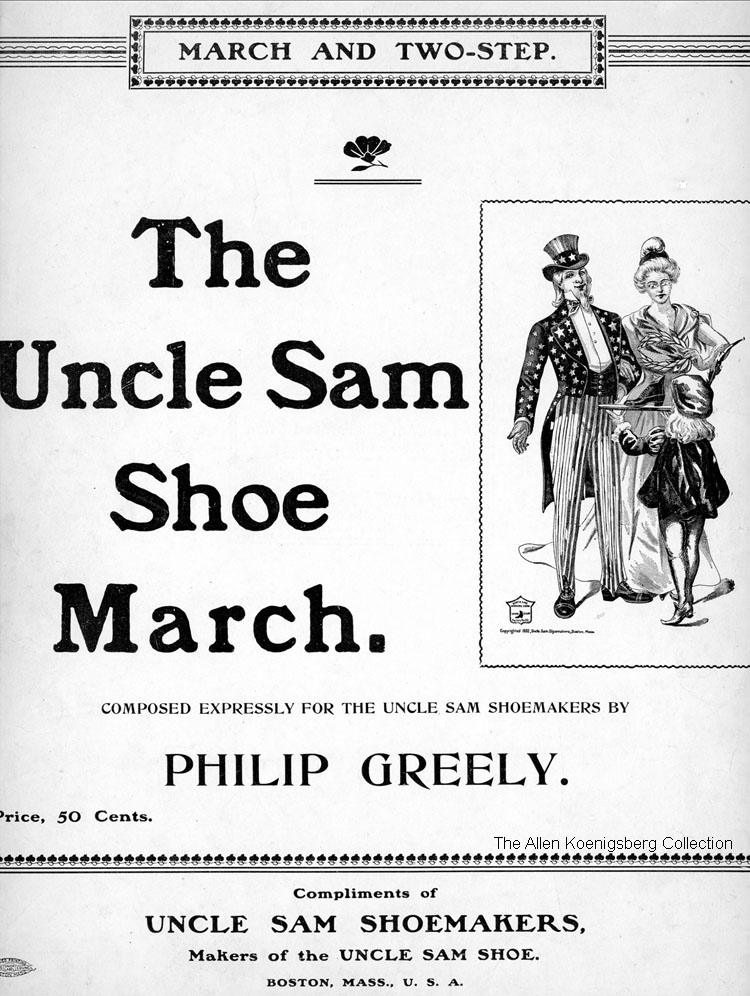
"The Uncle Sam Shoe
March," Composed by Philip Greely for the Uncle Sam Shoemakers,
1902 (Courtesy of Allen Koenigsberg).
The Uncle Sam Shoemakers company issued
a sales catalogue in 1905 with its cover featuring Uncle Sam holding
up a shoe with his left hand. Note the similar pose and hand positions
compared with Hub Gore's Uncle Sam Automaton at the World's Columbian
Exposition in 1893.
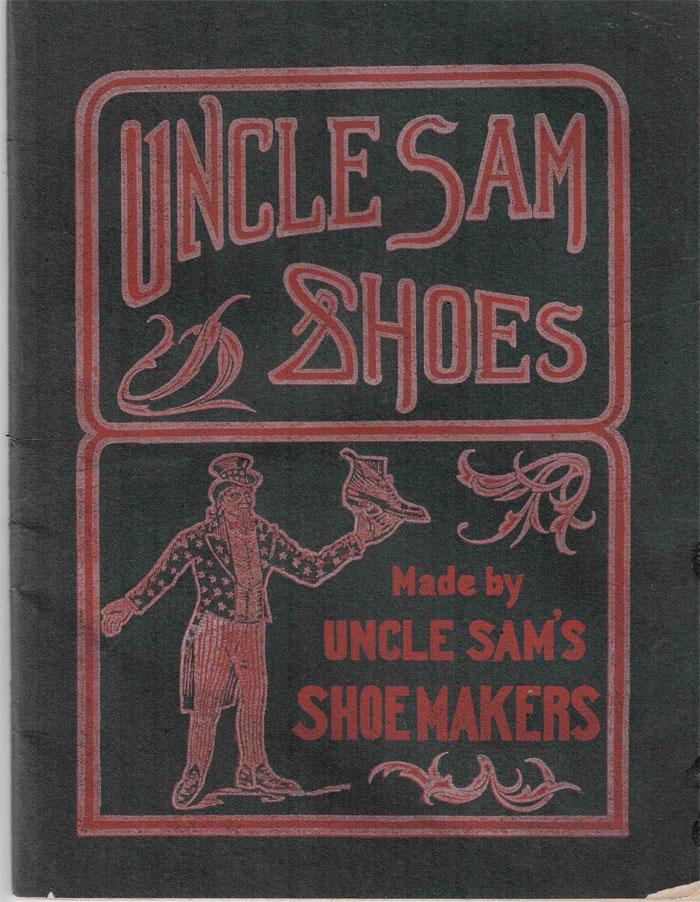
Uncle Sam Shoes Catalogue,
Made by Uncle Sam's Shoemakers, 1905 (Courtesy High
Ridge Books, Inc.)
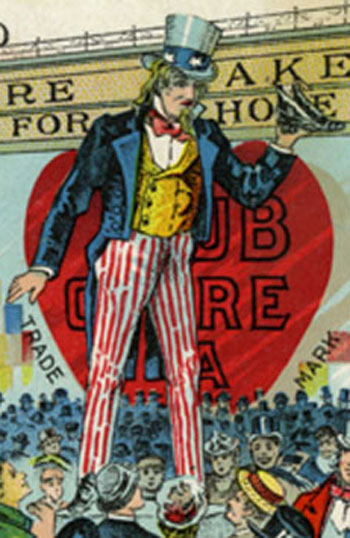
Hub Gore Makers' Uncle
Sam Edison Phonograph Automaton at the World's Columbian Exposition
of 1893
"Uncle Sam Booting the Mexican
Bandit"
This motion toy phonograph attachment
featured "Uncle Sam Booting the Mexican Bandit in Vigorous
Yankee Fashion and Boxing his Ears. The Mexican is Beating
It as fast as he can go."
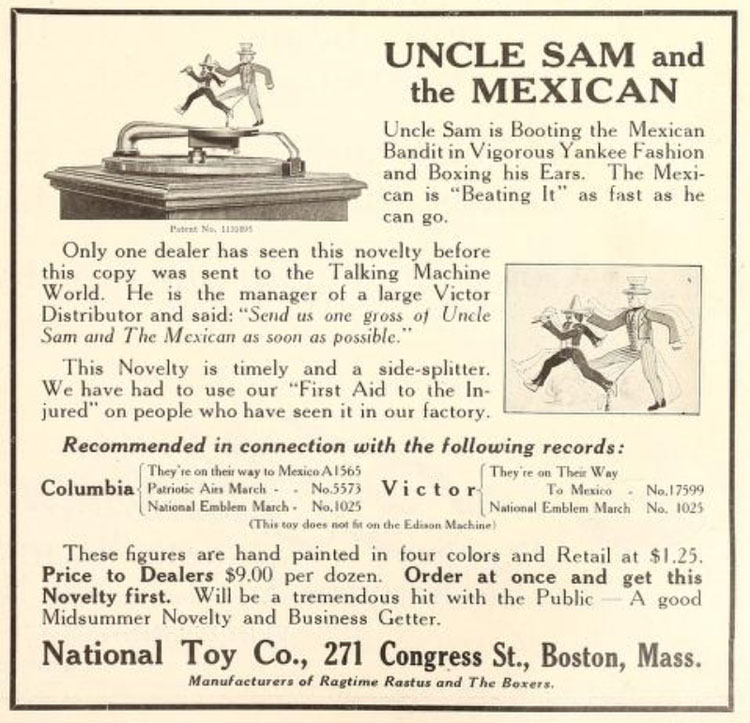
"Uncle Sam
and the Mexican," The Talking Machine
World, July 15, 1916
"Can" the Kaiser by
Uncle Sam
Another motion toy phonograph attachment
featured Uncle Sam booting, kicking, and "canning" Kaiser
Bill who is running away carrying his U-Boat "Pretzel."
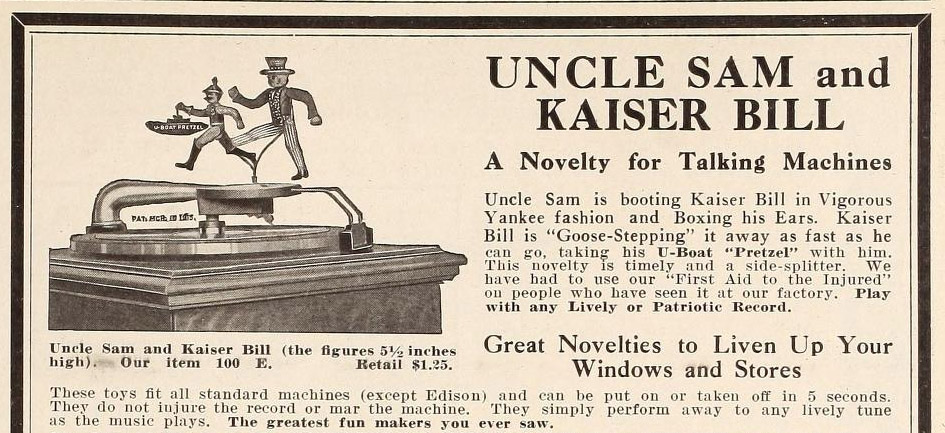
The National Toy Co., “Play with any
Lively or Patriotic Record.” The Talking Machine World, May
1917
"Can the Kaiser" by Adkins
& Fennell, Published by Adkins-Fennell Music Co., Kansas City,
MO, 1917 (Courtesy Library
of Congress).
LISTEN
to "The Kaiser and Uncle Sam" performed by Charlie
Oaks, Vocalion Record No. 15104, circa 1925. (Courtesy
i78s.org and David Giovannoni).
"Uncle Sam," composed
by Kidd, Elizabeth Ayresoser, Lyricist [Chicago: Kidd & Co,
1917] Notated Music, Library
of Congress.
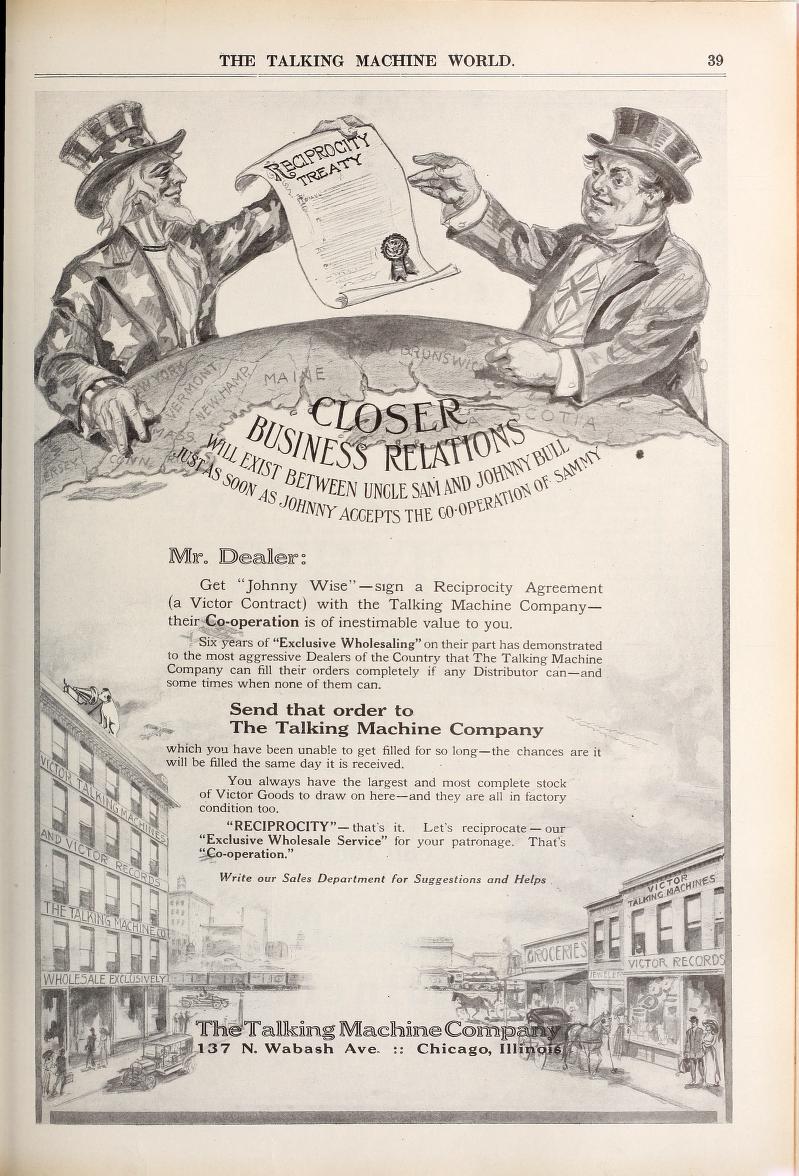
The Talking
Machine World, August
15, 1911
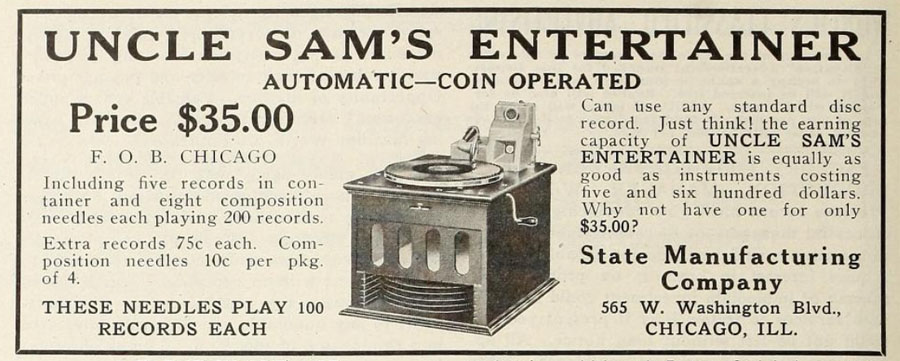
"Uncle Sam's Entertainer,"
The Talking Machine World, July
15, 1917
1943 Philco Corporation - Uncle
Sam is waiting for Victory when it can bring back its peacetime
products, e.g., radios, phonographs and "new wonders"
of entertainment.
For non-phonograph connected examples
of Uncle Sam and John Bull in popular culture see Phonographia's
Uncle
Sam Illustrations: Puck and Judge, 1880 - 1900.
Uncle Sam Connected Sheet Music
and Records (pre-1923)
There are many examples of Uncle
Sam being used in the title of a song or illustrated on the cover
of its sheet music. The following is a more limited list and selected
based on the Uncle Sam sheet music having an associated phonograph
record. Listen to each and enjoy the artwork as you transport
back in time with Uncle Sam.
THAT GRAND OLD GENTLEMAN (UNCLE
SAM)
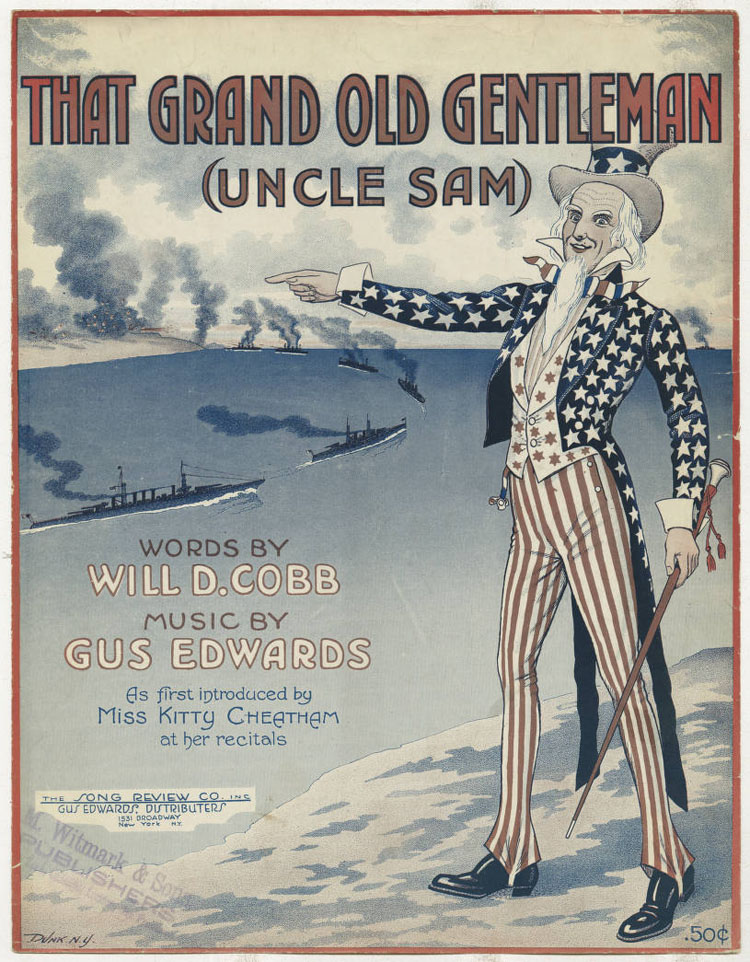
"He's long and
lean and lanky that grand old gentleman: Uncle Sam" Alternative
Title: "That grand old gentleman: Uncle Sam" Composer
Edwards, Gus; Lyricist Cobb, Will D.; Illustrator Dunk, Walter
M.; Published by Song Review Co., Inc., New York, 1918. (Sheet
Music and text: University
of South Carolina Libraries).
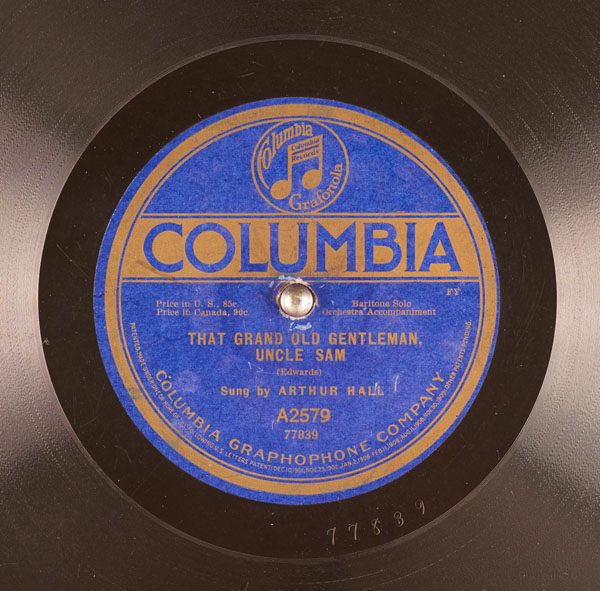
LISTEN:
"That Grand Old Gentleman, Uncle Sam,"
sung by Arthur Hall, Columbia Graphophone Company, 78 RPM Record
No. A2579); Released May 1918. (Source: Internet Archive).
I'M A REGULAR
DAUGHTER OF UNCLE SAM
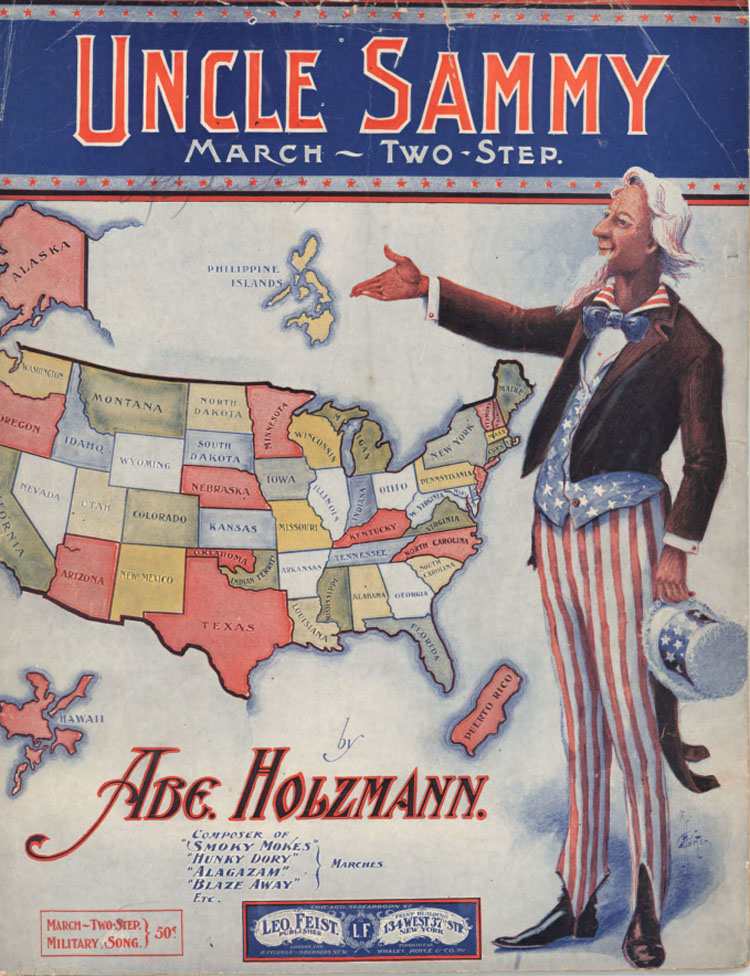
"Uncle Sammy," composed
by Abe. Holzmann. [New York: Leo Feist, publisher, 1905] March~Two-Step
(Sheet music and record courtesy of i78s.org and David Giovannoni-Sheram
Collection).
LISTEN
to "Uncle Sammy" - March and Two-Step (Holzmann),
Edison Military Band (Frank R. Seltzer, director) Edison Record
No. 8632, 2-minute Gold Moulded cylinder, released March 1904.
(Source of record: i78s.org).
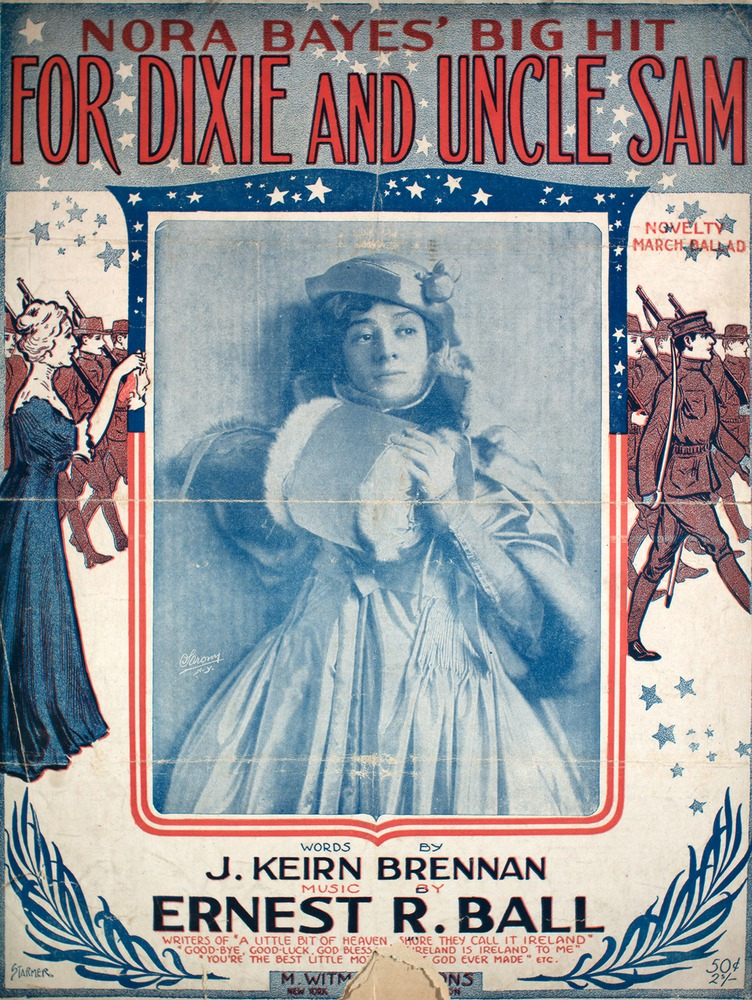
For "Dixie and Uncle Sam,"
Lyrics by J. Keirn Brennan. Music by Ernest R. Ball. M. Witmark
& Sons, New York, 1916.
LISTEN
to
"For Dixie and Uncle Sam" - Sung by Nora Bayes, Victor
10" Blue Label (Personality) Record No. 45100, Recorded June
1, 1916 (Source: Collection of David Giovannoni and i78s.org).
Alone she stands and waves her hand
To her boy who is going away.
She said, "I'm proud of you,
In your uniform of blue, And the sword that you carry too!
I've watched it twice before, Go bravely
off to war, For the Grey and then for the blue!"
Chorus:
Your Granddad fought in the war of
Sixty-One, He wore a suit of grey.
Your Daddy, too, in a unit of navy
blue, To Cuba sailed away.
Though the one wore grey and the other
blue, The blood of both's in you;
So I'm giving you up to Old Glory,
And I'm mighty proud that I
am!
You're all I've got, but be Johnny
on the spot, For Dixie, and
Uncle Sam!
UNCLE SAM MEDLEY
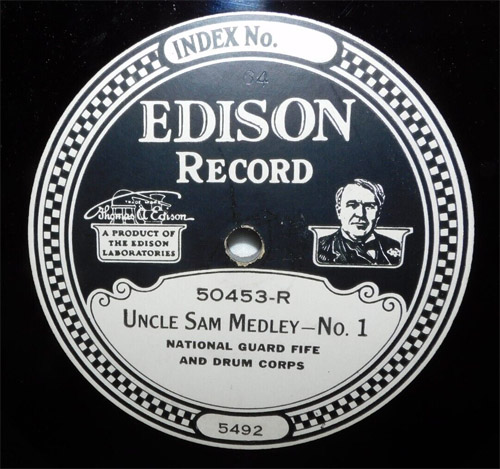
LISTEN
to Uncle Sam Medley - No. 1, National Guard Fife and Drum Corps,
Edison Domestic series 3218, 4-minute celluloid cylinder, Matrix
D-05492-B (Dub issued disc) (courtesy i78s.org and David Giovannoni
collection). Pictured (above) is the Edison Diamond Disc Record
No. 50453-R, Matrix 5492, 1917.
UNCLE SAM BLUES
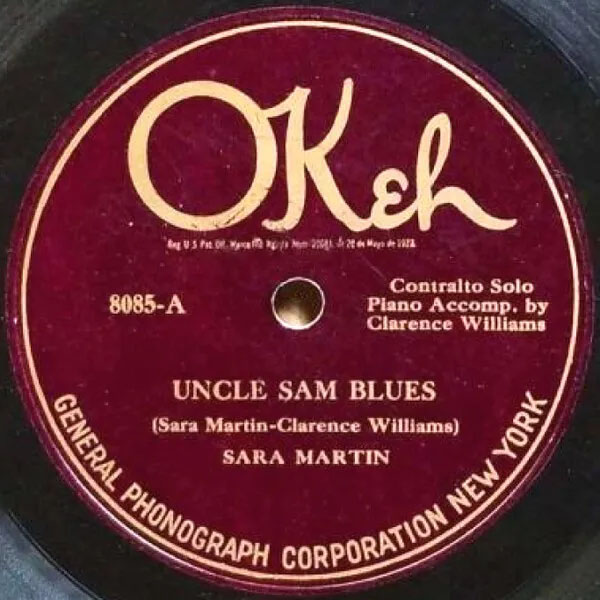
Sara Martin recorded "Uncle Sam Blues",
which she wrote with Clarence Williams, in New York on 17 July 1923
with Clarence Williams on piano. Record released in September 1923
(Source: Text and Okeh Record Label courtesy RateYourMusic.com).
LISTEN
to "Uncle Sam Blues" by Sara Martin on Spotify.
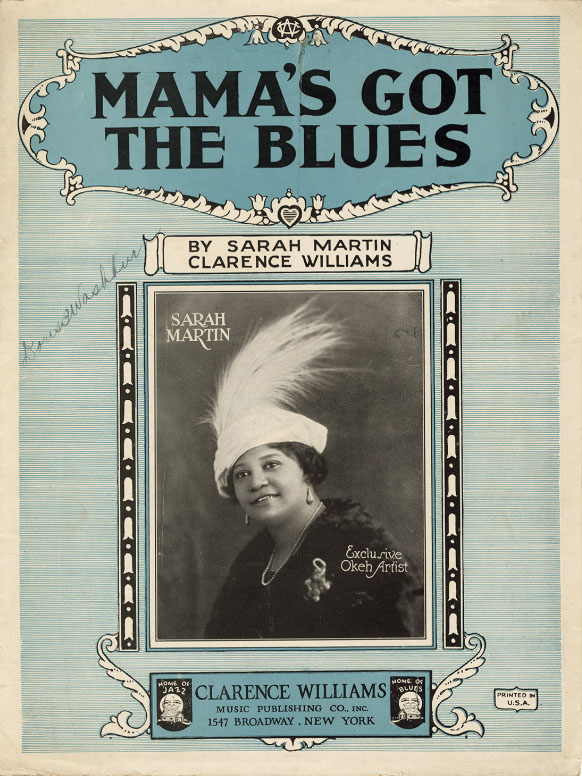
"Mama's Got the
Blues" by Sarah Martin, Clarence Williams Music Publishing
Co., Inc., New York, 1923. (Source: Potter & Potter Auctions).
No sheet music currently located for "Uncle Sam Blues."

LISTEN:
"Uncle Sam
Blues" (Source:
Discography of American Historical Recordings)
"Uncle Sam Blues"
by CLARA SMITH with Fletcher Henderson at the piano. Columbia
Phonograph Company Record No.12D Matrix: 81253, 78 rpm, Recorded
October 1, 1923. (Label and text source: DAHR
and UC Santa Barbara Library)
 Phonographia
|

